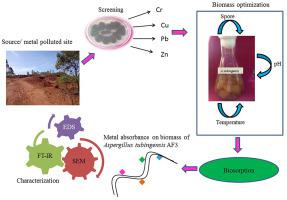Chemosphere ( IF 8.8 ) Pub Date : 2021-06-01 , DOI: 10.1016/j.chemosphere.2021.131055 Ponniah Anusha 1 , Mathiyazhagan Narayanan 2 , Devarajan Natarajan 1 , Sabariswaran Kandasamy 3 , Arunachalam Chinnathambi 4 , Sulaiman Ali Alharbi 4 , Kathirvel Brindhadevi 5

|
The intention of this research was to find the most eminent metal tolerant and absorbing autochthonous fungal species from the waste dump of a bauxite mine. Out of the 4 (BI-1, BI-II, BI-III, and BI-IV) predominant isolates, BI-II had an excellent metal tolerance potential against most of the metals in the subsequent order: Cr(VI) (1500), Cu(II) (600), Pb(II) (500), and Zn(II) (500–1500 μg mL−1). BI-II had shown tolerance to Cr(VI) up to 1500 mg L−1. The excellent metal tolerant isolate was characterized and identified as Aspergillus tubingensis AF3 through 18S rRNA sequencing method and submitted to GenBank and received an accession number (MN901243). A. tubingensis AF3 had the efficiency to absorb Cr(VI) and Cu(II) at <70 & 46.3% respectively under the standard growth conditions. Under the optimized conditions (25 °C, pH 7.0, 0.5% of dextrose, and 12 days of incubation), A. tubingensis AF3 absorbed 74.48% of Cr(VI) in 12 days (reduction occurred as 822.3, 719.13, 296.66, and 255.2 mg L−1 of Cr(VI) on the 3rd, the 6th, the 9th and the 12th day, respectively). The adsorbed metal was sequestered in the mycelia of the fungus in a precipitated form; it was confirmed by Scanning Electron Microscope (SEM) and Energy Dispersive X-ray analysis (EDX) analyses. The possible biosorption mechanisms were analyzed by Fourier-Transform Infrared Spectroscopy (FTIR) analysis, the results showed the presence of N–H primary amines (1649.98 cm−1) and Alkanes (914.30 cm−1) in the cell wall of the fungus, while being treated with Cr(VI) they supported and enhanced the Cr(VI) absorption. The entire results concluded that the biomass of A. tubingensis AF3 had the potential to absorb a high concentration of Cr(VI).
中文翻译:

从铝土矿尾矿中分离出的土生土长塔宾曲霉 AF3 六价铬 (VI) 生物吸附能力的评估
这项研究的目的是从铝土矿的废物堆中找到最杰出的金属耐受性和吸收性本土真菌物种。在 4 个(BI-1、BI-II、BI-III 和 BI-IV)主要分离株中,BI-II 对以下顺序中的大多数金属具有极好的金属耐受潜力:Cr(VI) (1500 )、Cu(II) (600)、Pb(II) (500) 和 Zn(II) (500–1500 μg mL -1 )。BI-II 已显示出对 Cr(VI) 高达 1500 mg L -1 的耐受性。通过18S rRNA测序方法对优良的耐金属分离株进行表征和鉴定为塔宾曲霉AF3,并提交给GenBank并获得登录号(MN901243)。塔宾曲霉在标准生长条件下,AF3 吸收 Cr(VI) 和 Cu(II) 的效率分别<70% 和 46.3%。在优化条件下(25 °C、pH 7.0、0.5% 葡萄糖和 12 天孵育),塔宾曲霉AF3 在 12 天内吸收了 74.48% 的 Cr(VI)(还原为 822.3、719.13、296.66 和255.2毫克的L -1的3铬(VI)的RD,该6个,第9个和12个第天,分别)。吸附的金属以沉淀形式被隔离在真菌的菌丝体中;扫描电子显微镜 (SEM) 和能量色散 X 射线分析 (EDX) 分析证实了这一点。通过傅里叶变换红外光谱 (FTIR) 分析可能的生物吸附机制,结果显示真菌细胞壁中存在 N-H 伯胺 (1649.98 cm -1 ) 和烷烃 (914.30 cm -1 ),在用 Cr(VI) 处理时,它们支持并增强了 Cr(VI) 的吸收。整个结果得出结论,塔宾曲霉AF3的生物量具有吸收高浓度 Cr(VI) 的潜力。



























 京公网安备 11010802027423号
京公网安备 11010802027423号